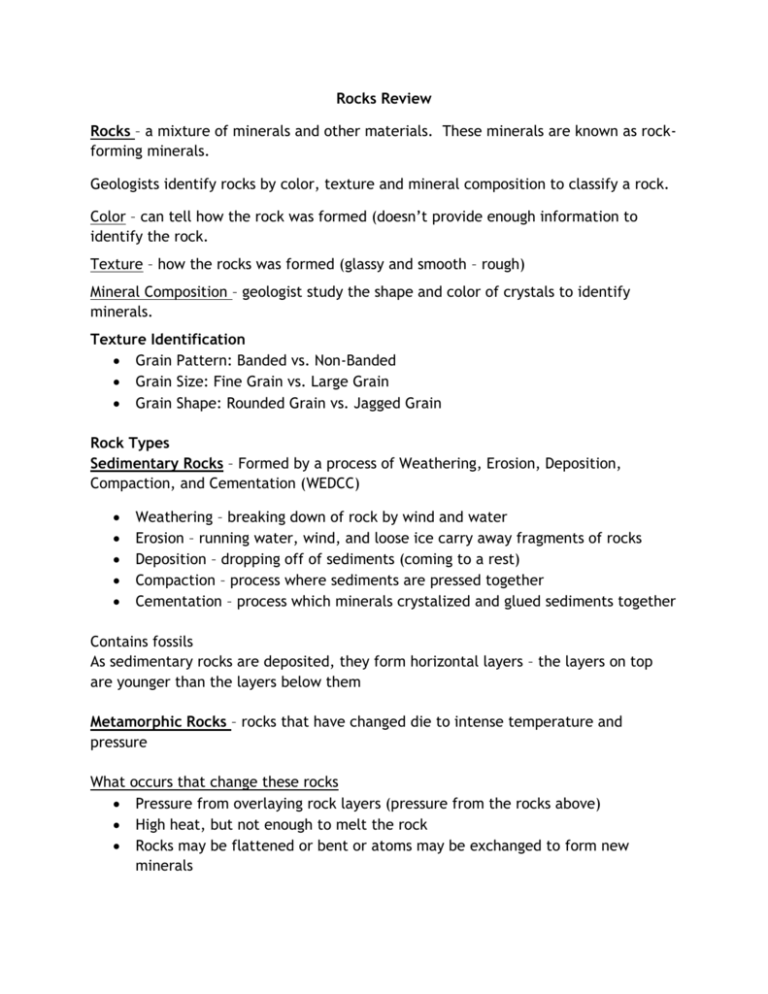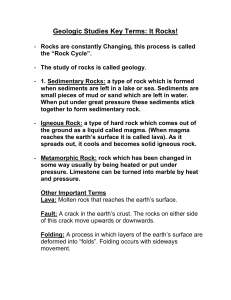Rocks Review Rocks – a mixture of minerals and other materials
advertisement

Rocks Review Rocks – a mixture of minerals and other materials. These minerals are known as rockforming minerals. Geologists identify rocks by color, texture and mineral composition to classify a rock. Color – can tell how the rock was formed (doesn’t provide enough information to identify the rock. Texture – how the rocks was formed (glassy and smooth – rough) Mineral Composition – geologist study the shape and color of crystals to identify minerals. Texture Identification Grain Pattern: Banded vs. Non-Banded Grain Size: Fine Grain vs. Large Grain Grain Shape: Rounded Grain vs. Jagged Grain Rock Types Sedimentary Rocks – Formed by a process of Weathering, Erosion, Deposition, Compaction, and Cementation (WEDCC) Weathering – breaking down of rock by wind and water Erosion – running water, wind, and loose ice carry away fragments of rocks Deposition – dropping off of sediments (coming to a rest) Compaction – process where sediments are pressed together Cementation – process which minerals crystalized and glued sediments together Contains fossils As sedimentary rocks are deposited, they form horizontal layers – the layers on top are younger than the layers below them Metamorphic Rocks – rocks that have changed die to intense temperature and pressure What occurs that change these rocks Pressure from overlaying rock layers (pressure from the rocks above) High heat, but not enough to melt the rock Rocks may be flattened or bent or atoms may be exchanged to form new minerals How metamorphic rocks are classified Foliated – mineral grains are flattened and line up in parallel bands Non-Foliated – no bands are formed Where metamorphic rocks usually form Where magma intrudes relatively cool rock Near colliding boundaries (near mountain ranges) Places that are covered miles thick with other rock causing pressure When hot water intrudes rock Where a meteorite strikes Earth (rare) Where lightning bolts strike rocks (rare) Igneous Rock – formed from the cooling of either magma (below earth) or lava (above the earth) Intrusive Rock – inside the earth – magma - usually have large crystals-cooled slowly due to heat within the earth Extrusive Rock – above the earth – lava (volcanoes) – small or no crystals – cooled quickly due to lava reaching the cool air The most abundant type of rock What is the process through which rocks change? The Rock Cycle is a series of processes on Earth’s surface and in the crust and mantle that slowly change rocks from one kind to another. (Takes thousands of years to go through the process) Once a rock is formed it does NOT stay the same rock forever – Rocks are continually changing (WEDCC – Heat and Pressure – Melting and Cooling)








